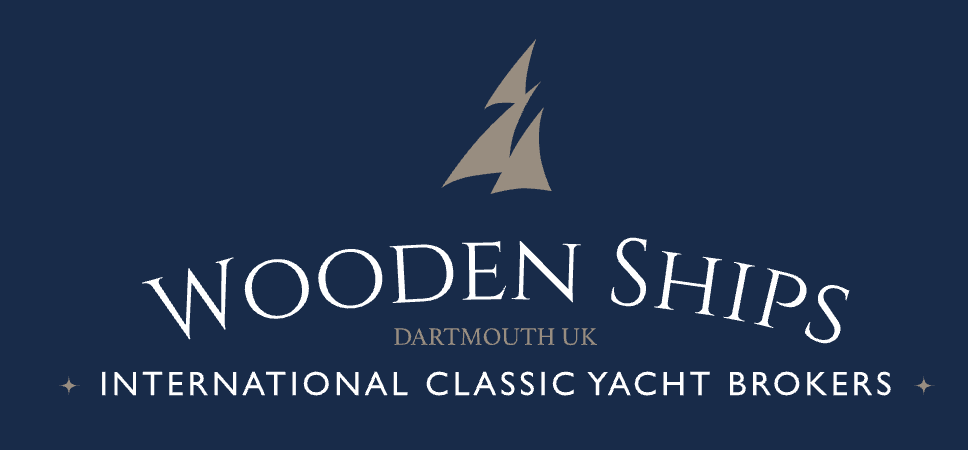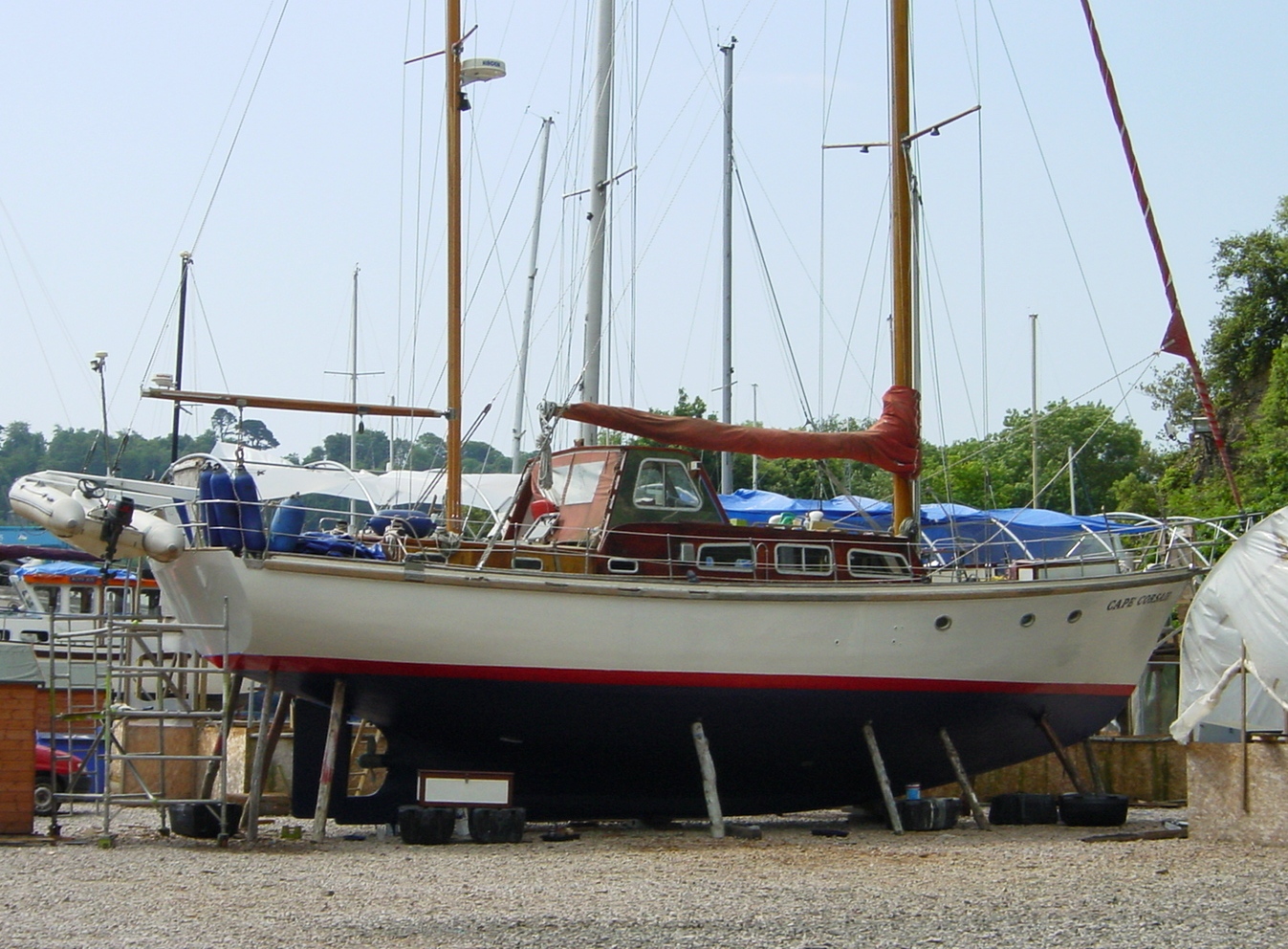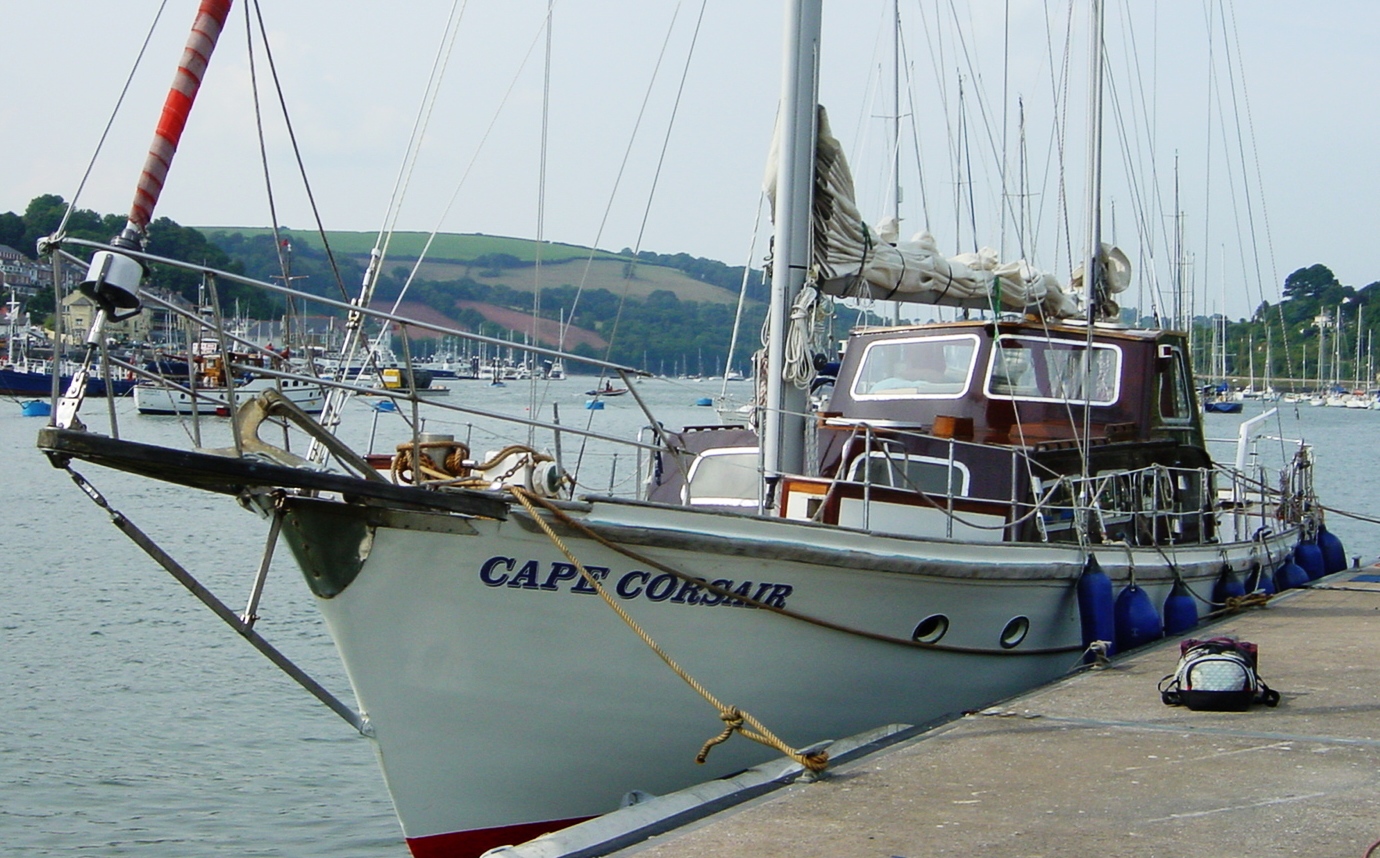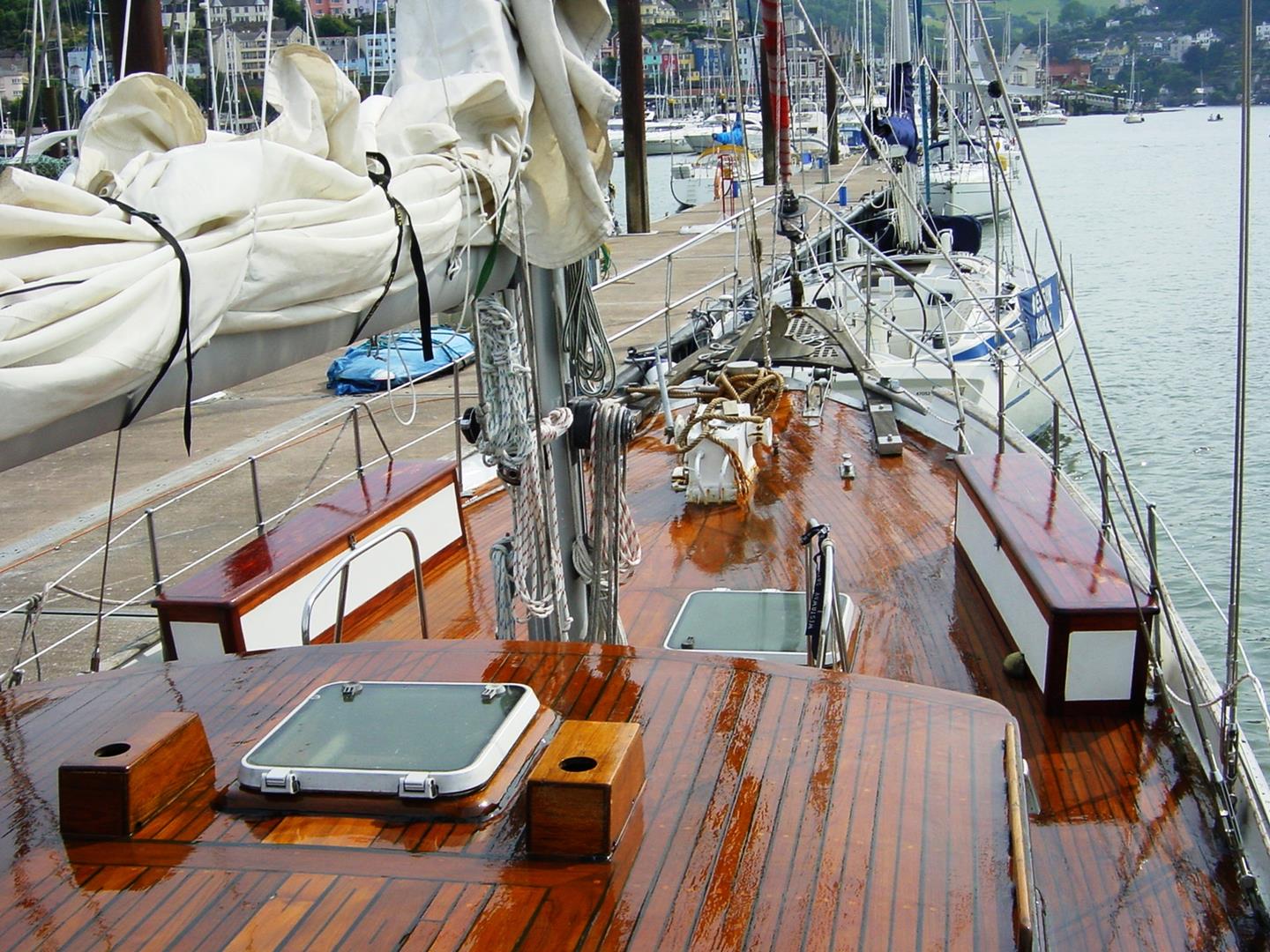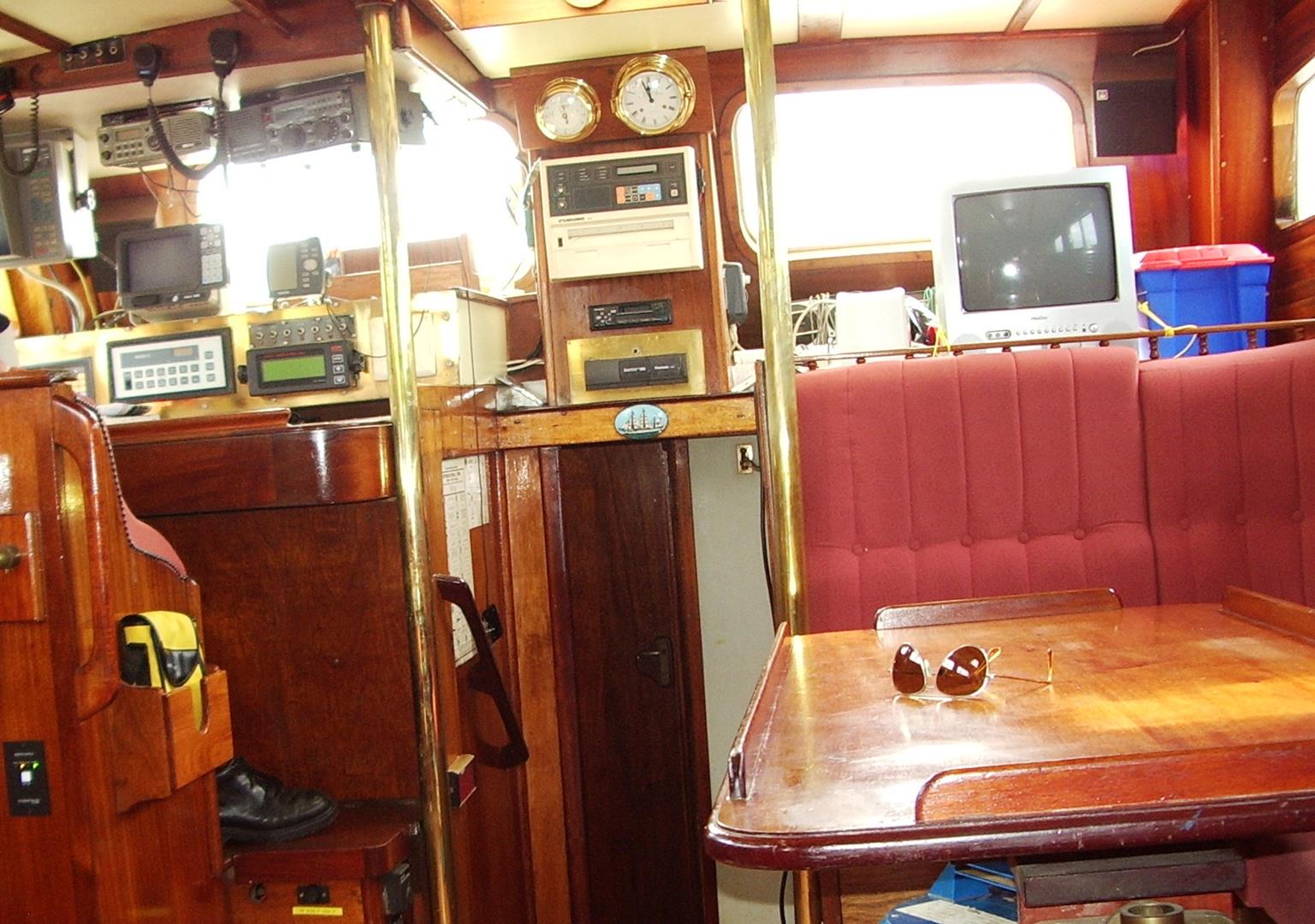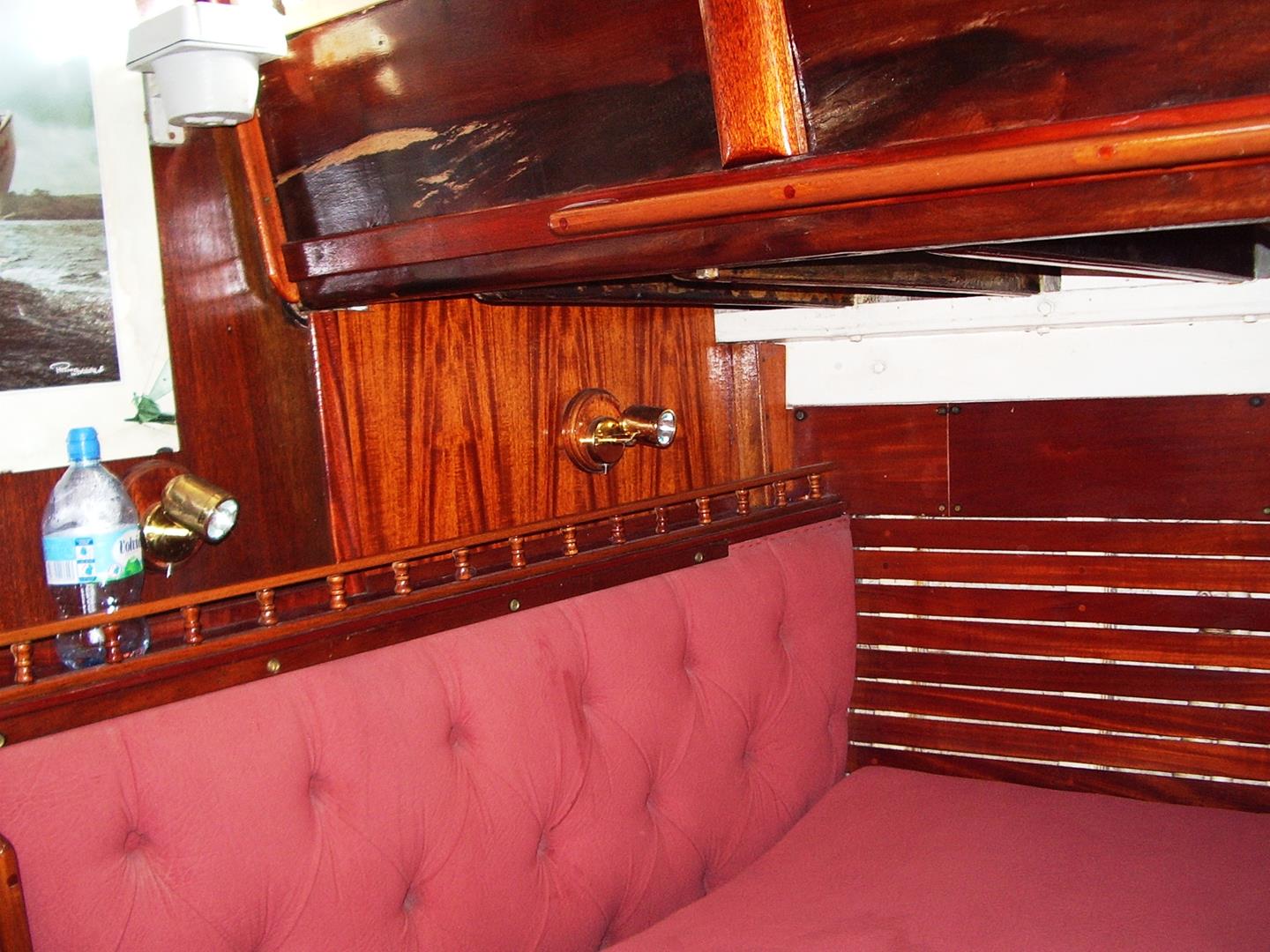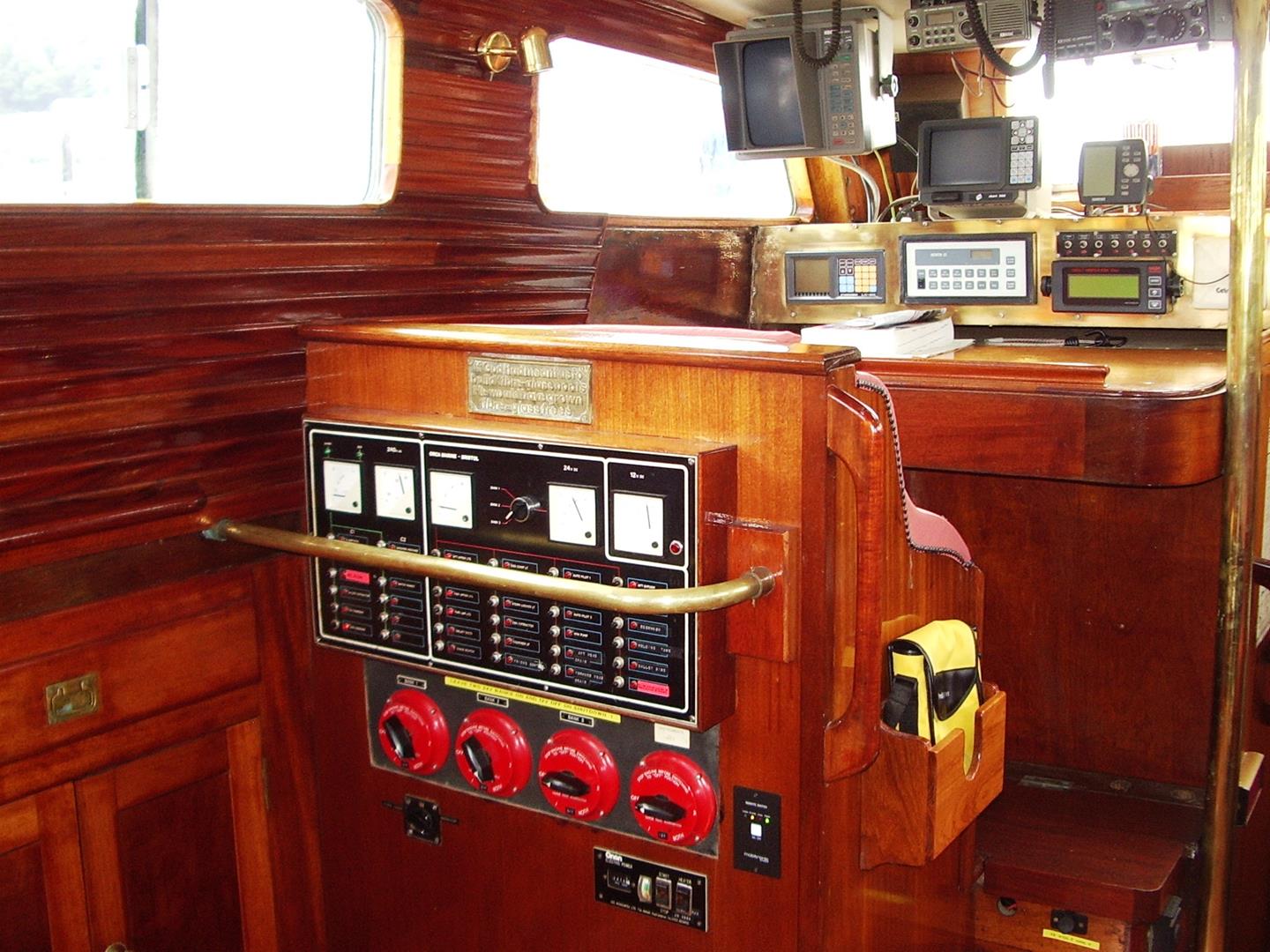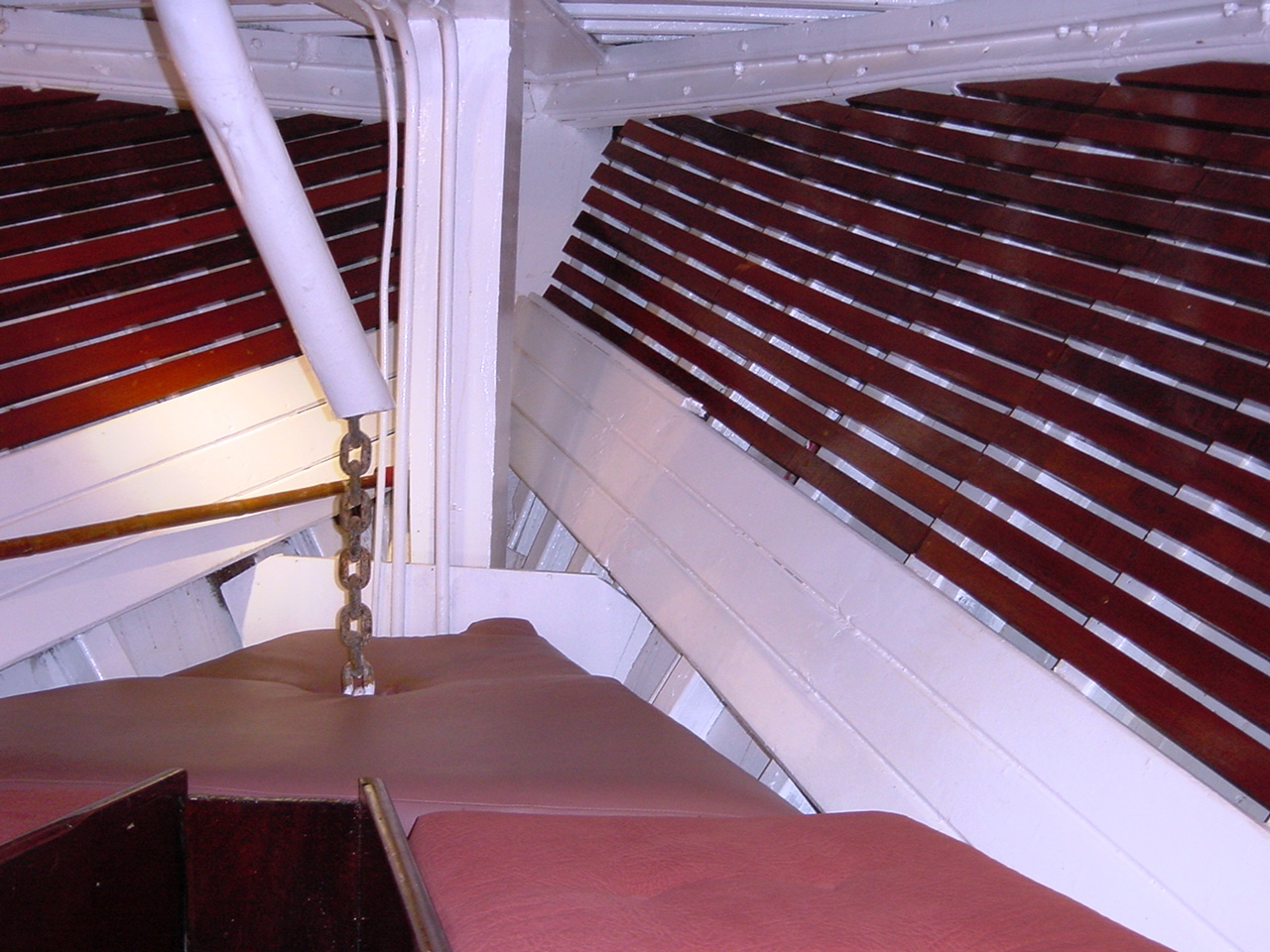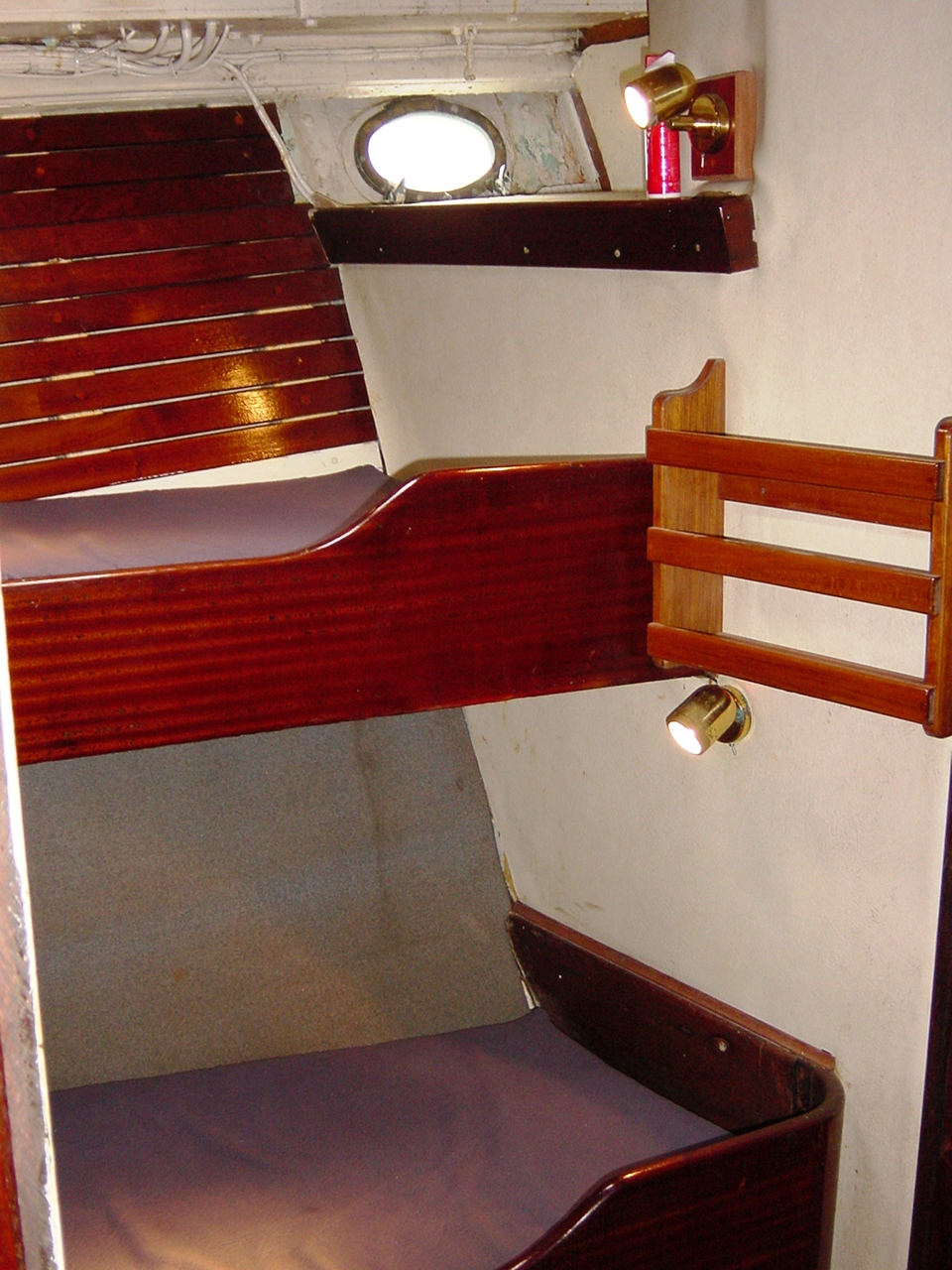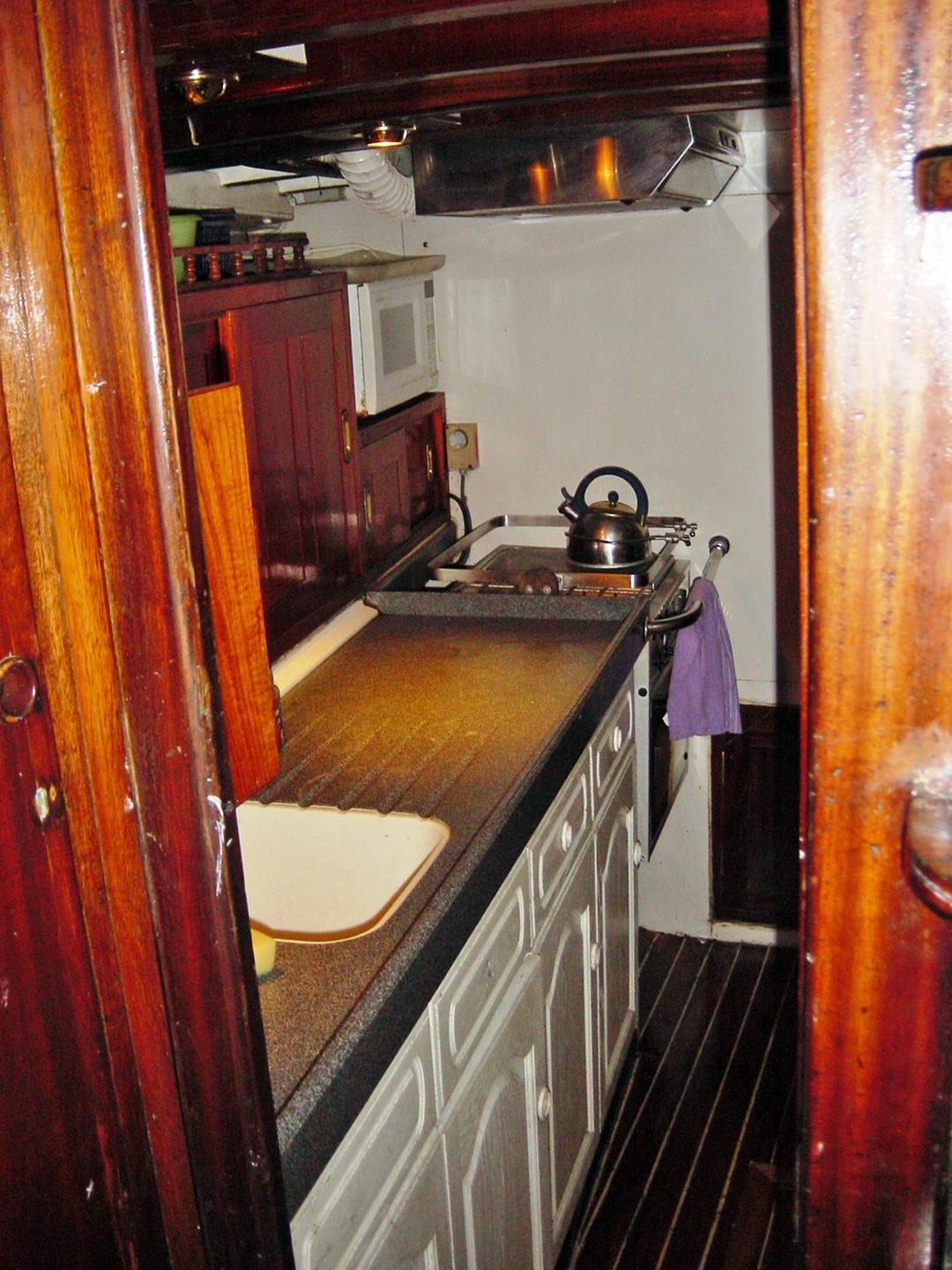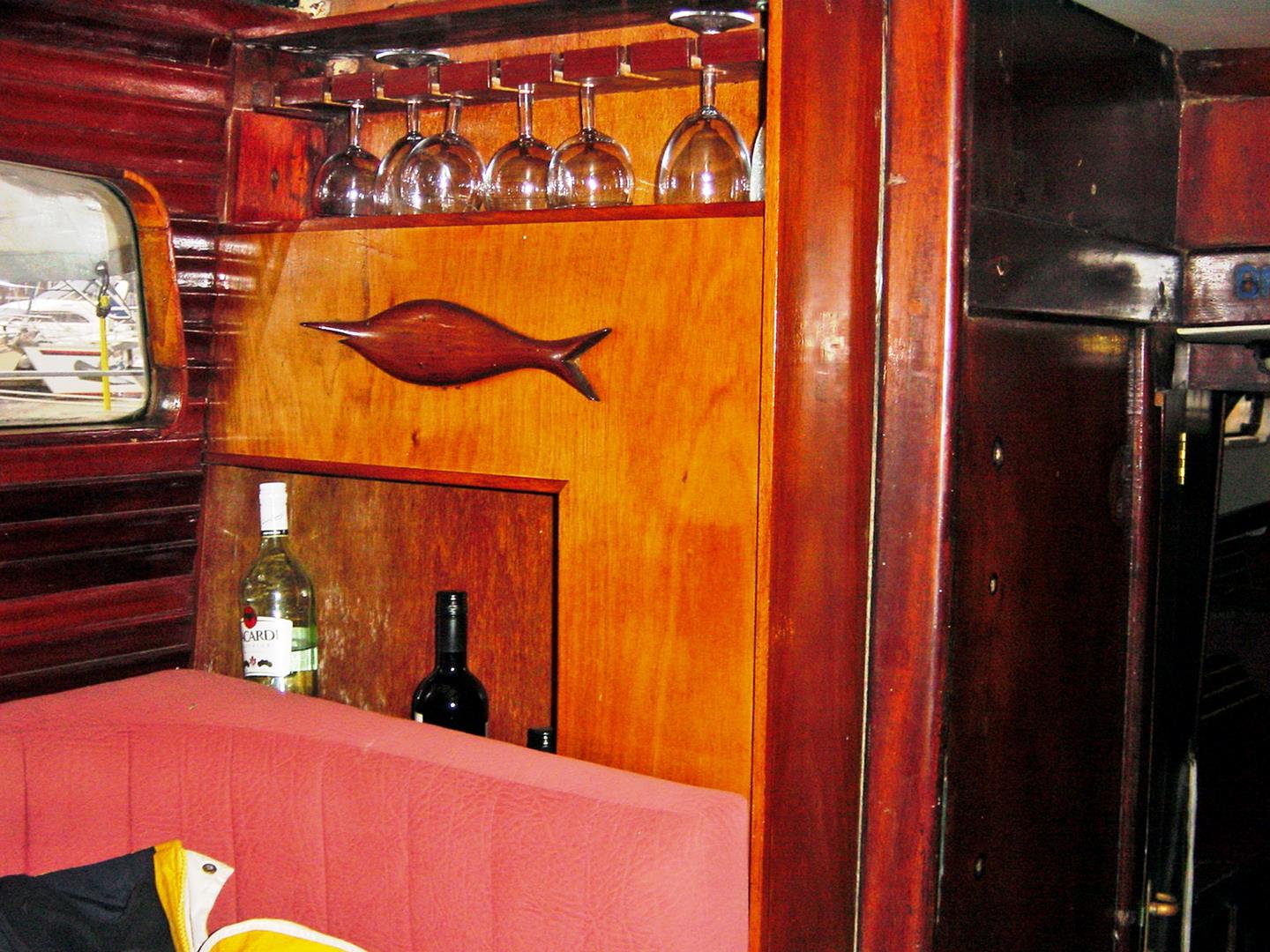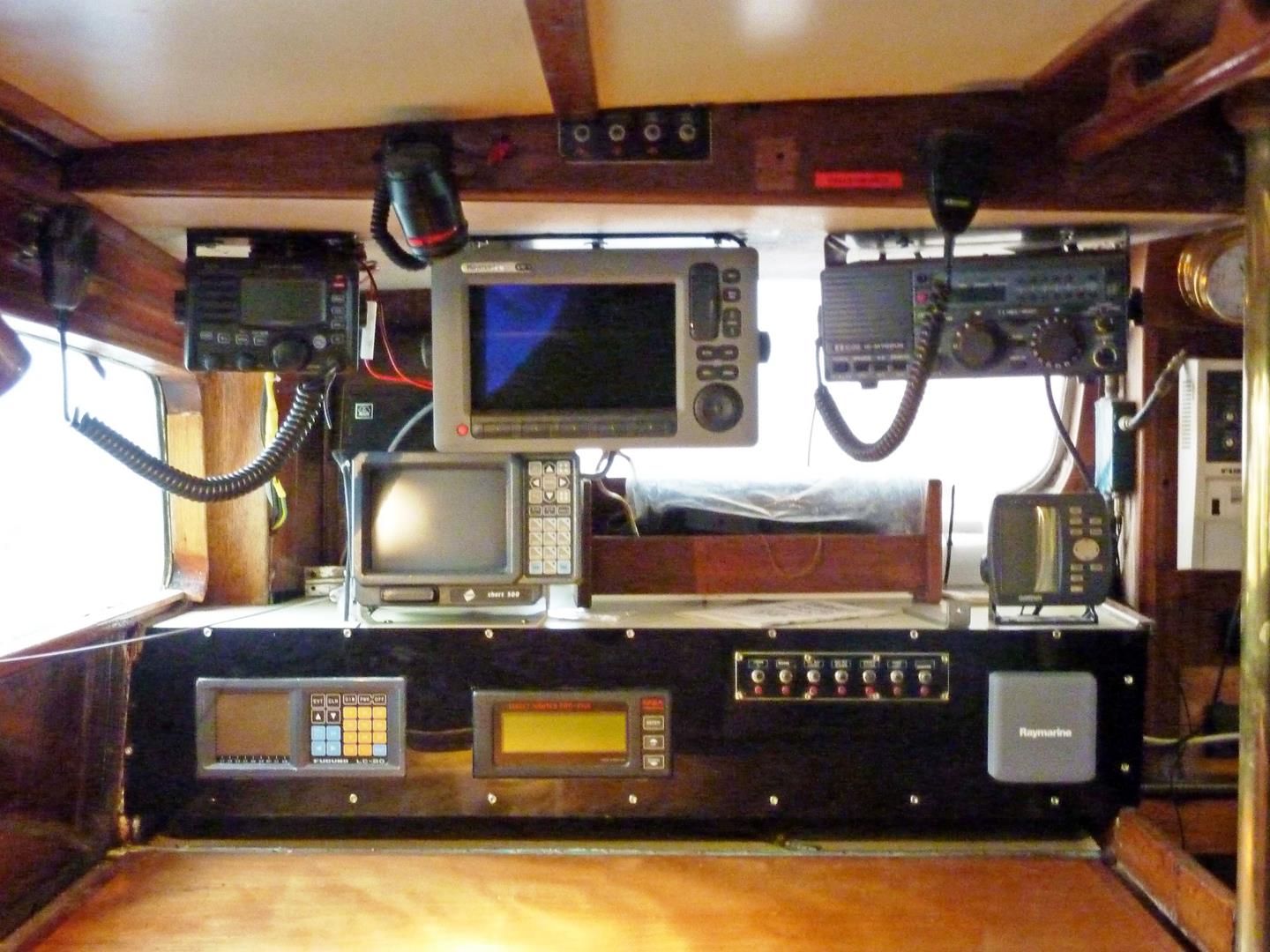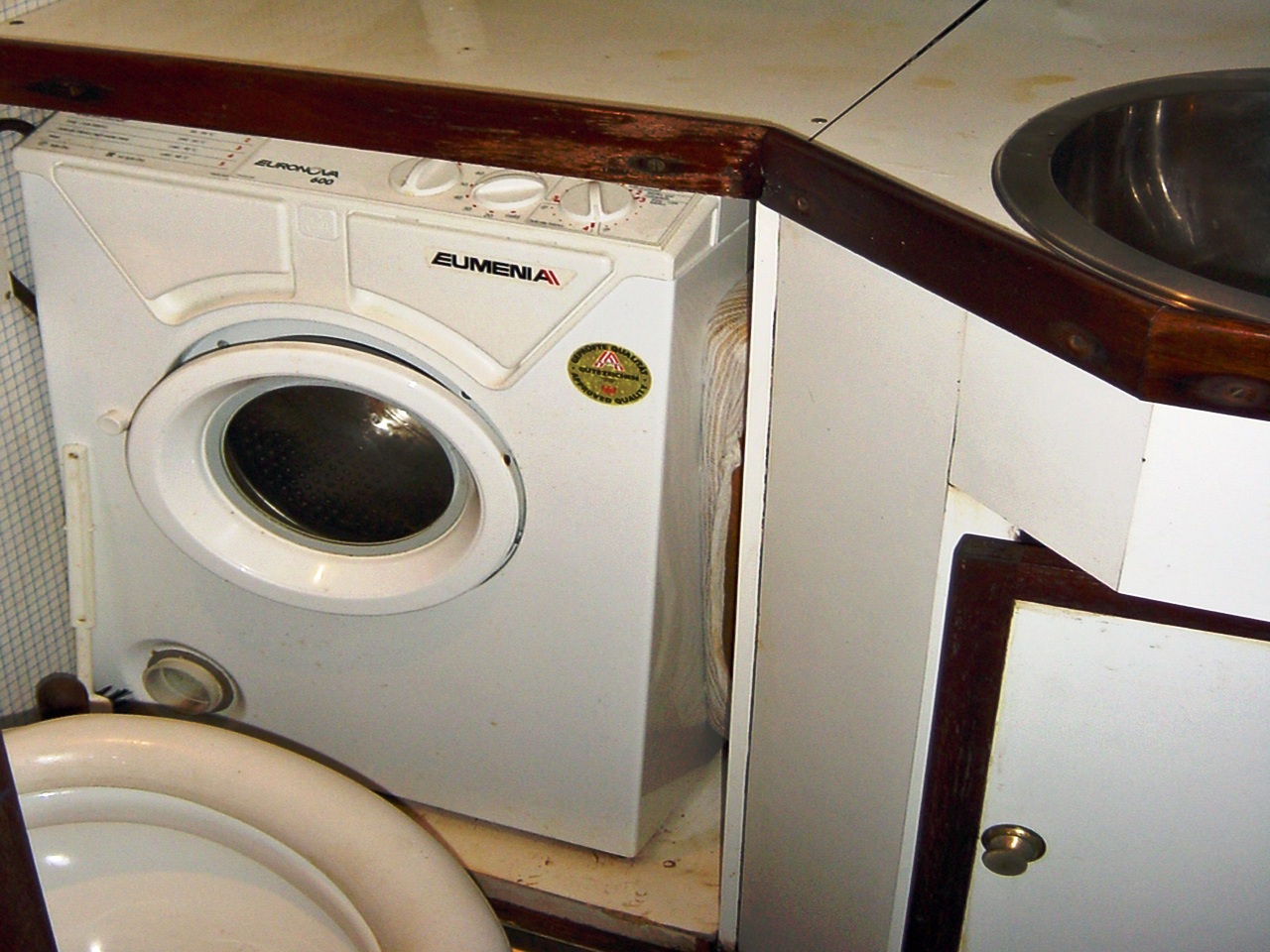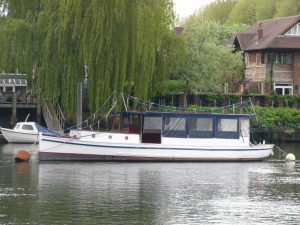HISTORY & DESCRIPTION:
CAPE CORSAIR was built in South Africa in 1961 from the famous yard in Cape Town of Louw & Halverson from a design submitted by the renowned international yacht designer Kurt A.H.Oehlmann of Lubeck, Germany, whose classic designs of timber framed vessels are much desired. She has only had two owners since new!
Col Stanley Jeffrey the original owner requested of the design that she be able to withstand the rigours of the Cape waters and be capable of 9 knots under sail or power. She has proved to be more than able to do both.
She first left Cape Town in April 1964 and went to the Mediterranean via St Helena, Ascension, Cape Verde, Canaries and Gibraltar. For the 5850 miles she sailed she took 35 days at sea at an average speed of 7 knots and averaged 167 miles per day.
She is a classic 18 metre, 35 tonne wooden ketch some 5 metres in beam and is cutter rigged with roller furling Genoa and inner foresail, a slab reefed main and mizzen; together with a mizzen staysail to compliment her down wind sailing ability.
HULL
The hull is made from double planked Nigerian mahogany some 38mm in total thickness running fore and aft, with the seams staggered. She has conventional caulking at the garboards only and has never taken any water. The planks are all scarfed – there are no butt blocks – and they are screwed into laminated frames, 3inch x 3 inch x 4 inches on 11 inch centres and screwed to each other in between the frames. Each plank had a small groove bruised into the centre of the edge as it was put on and a single strand of caulking was laid as she was planked up which was all done as a precaution until she took up initially; subsequently she has been a dry boat and has no hull seam leakage.
The laminated frames are of American oak screwed and glued using Resorcinol glue.
Both hull and frames are in superb order some 50 years on, standing both the test of time and the designer’s remarkable foresight.
The Hull is strapped diagonally with naval bronze running from keel to sheer at intervals the whole length of the boat.
The silicon bronze chain plates are 8 feet long and 2 feet deep and the shroud plates are bolted using 4 x ¾ inch bronze bolts on either side.
DECKS
The decks are 25mm thick teak glued and screwed to 19mm thick marine ply on to oak cross members and deck beams using thousands of silicon bronze screws in the construction.
KEEL
The wooden keel is shaped out of a 3 foot wide piece of oak and the 11 tonne lead keel is bolted through using 12 massive 25mm stainless steel bolts some 18 inches long.
MASTS
The main mast is 60 feet high and is manufactured by Z Spars, fitted in 2010 to exacting design standards with 12mm diameter stainless shrouds all designed and fitted at the same time by Rigging Solutions of Dartmouth
The mizzen mast is some 40 feet high also manufactured by Z Spars and of similar construction to the main, utilising 10mm diameter shrouds.
Both masts are of a flat sided elliptical shape.
They are both stepped on deck into standard deck shoes and the main mast has a fabricated steel support under the deck down on to a 8 foot long jarrah mast step block.
The mizzen is supported by an 8 inch x 4 inch mahogany mast step.
Both were also replaced in 2010 , supplied by Z Spars and are of modern aluminium construction with matching aluminium booms.
Lazy Jacks are fitted to ease sail handling and the simple slab reefing system is uncomplicated and easy to use.
Spreader lights are factory fitted and provide the deck with excellent night time illumination together with the large foredeck light fitted to the main mast.
ENGINE
The engine is a “CATERPILLAR” D320B 4 cylinder diesel engine developing some 70 BHP at 1000 rpm giving a comfortable cruising speed of 8.5 knots or a maximum of 10 at 1500 rpm. Cruising fuel consumption is 1.5 gallons per hr.
The exhaust system is a 5″ Diameter, “Halyard” wet silenced system with electronic over temperature warnings
PROPELLER AND GEARBOX
The propeller and gearbox were designed and manufactured by Slack and Parr of Oldham, now part of the F. Bamford Group of Stockport.
The drive uses a dry plate clutch from the “Caterpillar” engine and the 1 metre diameter 3 blade phosphor bronze propeller is of the variable pitch type which utilises alterations of pitch to provide propulsion forward and astern as well as allowing a fully feathered position to obviate any drag when pure sailing.
Pitch can be gradually wound on to supply infinitely variable power, which is extremely useful during anchoring or mooring against sea currents.
The gearbox provides a 2:1 reduction from the engine and cruising range under power is 1200 nautical miles.
AUXILIARY GENERATOR
Is an “ONAN” 6 KVA diesel generator providing A/C Power of 220 Volts at 50Hz. The unit is water cooled, runs at 1500 rpm and is exceptionally quiet. It was fully overhauled in 2008 ready for the 2009 season.
It also supplies all the 24v and 12volt system charging facilities.
“Shore Power” can be supplied in addition by means of a cross over switch whilst shore side.
BATTERIES AND CHARGING
Three 24volt banks, arranged by pairing 6, 110 amp hour 12volt batteries; are charged by a “Waeco” Mobitronic 25 amp hour, fan cooled 240 volt charger as well as a “Siemans ” 24 volt dynamo which is separately powered by the Caterpillar engine.
One 12 volt bank comprising four 110 amp hour 12volt batteries in series is charged by a 20 amp hour “Cetrek” charger and also a “Bosch” 12v alternator also powered separately by the Caterpillar engine.
WATER SUPPLIES ON BOARD
A “Cleghorn Waring” pressurised hot and cold water system is installed feeding two shower rooms and toilets as well as galley and deck shower facilities. The water is heated either by engine circulating water or by 500 watt 240 volt immersion heater. This water is fed from two 250 gallon fresh water tanks via two independent pressure pumps. Freshwater can be supplied to the tanks by a “Marinco” desalination plant which can make 90 litres of fresh water per hour using two 240volt sea water pumps through a system of filters.
NAVIGATION EQUIPMENT AND RADIOS
Digital Radar 4KW by “Raymarine”
GPS & Chart Plotters “Raymarine”
VHF DSC Radio by “Icom”
AIS Integrated System “Digital”
HF/MF SSB Radio by “Icom”
Weather fax by “Furuno”
Loran C set by “Furuno”
Navigation Computer & Mast Head Equipment by “Raymarine”
Navtex by “Simrad”
Distress Beacon by “Kannad”
Autopilot (S3G) by “Raymarine”
NAVIGATION EQUIPMENT AND RADIOS – Continued
The core navigation and communication system was totally replaced in 2010 and instrumentation upgraded at both the helm and navigators position.
The “Raymarine” integrated system combines all navigational disciplines and with the addition of the AIS gives enhanced security and visibility to other shipping.
Laptop computers can be used in addition by the use of the fitted USB system links to download mapping or other information.
The VHF radio is fitted with an auxiliary helm hand set should the helmsman require to communicate directly.
STEERING, AUTOPILOT AND OTHER RELATED EQUIPMENT
The steering system is by “Teleflex” and is operated by hydraulic rams which are either powered by a helm position manual pump or a stepping hydraulic pump receiving movement instructions from a “Raymarine S3G” autopilot computer with internal gyroscope. This unit was fitted in 2008 to upgrade the previous “Cetrek” system.
The “Raymarine” chart display system can control heading by direct communication with the autopilot system
MAINTENANCE
She has been constantly overhauled and maintained and improved over the last twenty five years The systems currently employed allow her to be totally self sufficient both in power and water making her virtually “marina free”. Long passages away from land can be made in comfort with all the freedoms available from a constant on board water and power supply.
In 2010 yet another major overhaul was undertaken, replacing both the masts, running and standing rigging, together with a full upgrade of the electronic systems to bring the vessel to within modern marine quantifiable industry standards and to improve sailing performance.
DECK AND SUPERSTRUCTURE IMPROVEMENTS
The hull was spray painted using the highest quality AWLGRIP paints then and the decks coated with “COELAN” a transparent and lasting sealer developed recently in Germany which both protects and renders them impervious to water. This was a very expensive and time consuming process with magnificent results.
MACHINERY & EQUIPMENT
The Anchor windlass is by “Simpson Lawrence” and is hydraulically powered via a pump driven by the main Caterpillar engine.
There is an “Eberspacher” diesel powered warm air heater fitted in the main saloon giving 3 kilowatts of heat fully rebuilt in 2010.
Refrigeration of foodstuffs is supplied by a “Penguin Engineering” system comprising a large deep freeze adjacent to and refrigerator facilities fitted within the galley also fully overhauled in 2010.
A “Taylor” four burner gimballed stainless steel stove with grill and oven is fitted in the galley.
A “Hotpoint” 750 watt Microwave oven is also fitted in the galley.
There is fitted a “I.M.P” special purpose stainless steel washing machine in one of the shower rooms. This is fed with cold water from the fresh water system and uses the 240 volt electricity supply.
All cabins have 3 pin 240 volt sockets.
There is an “Avon” 10 foot auxiliary dinghy mounted in Simpson Stainless Steel davits on the stern and propelled by a 15hp Mercury outboard.
ACCOMMODATION
Two crew berths in the Forepeak.
Two single berths mid forward position.
Mid Aft double berth.
One master stateroom with double berth.
Single berth astern
Two shower rooms with washbasin and toilets.
Well appointed Galley area with sinks drainers, cooking & storage facilities.
Boatswains locker in a lazarette complete with a large selection of running spares.
The large 5 metre x 4 metre saloon dining and navigation area.
Engine and engineering facility room beneath the saloon.
ENTERTAINMENT
Compact Disc Player and Radio facility with high power speakers in the saloon and extension speaker outlets also fitted in the wheelhouse.
There is a digital television booster aerial fitted to the mizzen mast and the amplifier socket powers the TV input most successfully.
There is a Digital LCD TV fitted starboard hand side of the saloon on a swing bracket and can be safely stowed whilst under way if necessary.
ACCOLADES and ACHIEVEMENTS
She has been sailed round the world twice and has cruised extensively in the Mediterranean.
Her logs and papers are littered with references to exotic places and cruising areas.
She sailed out in 1968 from Cape Town to rescue Commander Bill King who had been capsized and partially dismasted during the round the world race in “Galway Blazer”, some 1100 miles south west of the Cape. Corsair towed her some 200 miles back to Cape Town after successfully locating her in the Atlantic. She is therefore “mentioned in despatches”
Plus places in the following events
Simonstown to Port Elizabeth Race 1962
Capetown to Lamberts Bay Saldahna Race 1963
Whangarei, New Zealand to Noumea Race 1967
Capetown to Rio de Janeiro Race 1971
Capetown to Rio de Janeiro Race 1972
Capetown to Rio de Janeiro Race 1973
Capetown to Malta via St Helena, Cape Verde’s, & the Azores. 1986
Malta to Bristol 1987
Bristol to Almeria 1988
Majorca to Dartmouth 1990
Brest Wooden Ships Festival 1992
Bristol Sea Festival 1996
St Nazaire Classic Yachts Festival 1997
SAILING ABILITIES & OWNERS COMMENTS:
Cape Corsair is exceptionally fast off the wind and due to the long 11 Tonne lead keel takes heavier sea conditions in her stride.
Cruising downwind in say force 4 or 5 she will comfortably make some 8 or 9 knots.
35 to 45 degrees to wind is her best upwind although this can be improved by motor sailing in lighter airs if speed is of the essence.
The Caterpillar gives her some 7 knots with no sails and 10 knots off the wind under controlled conditions.
With a good crew and a balanced boat we have achieved 12 to 13 knots, but things are getting interesting at that stage.
Simple slab reefing and roller furling achieve positive results every time and there should be no difficulties managing sails with a short handed crew.
Fuel consumption at 1200 rpm (cruising) is about 1.1/2 gallons per hour at 7 knots.
The variable pitch prop operated by a hand wheel at the helm position makes coming up to a buoy very controlled and easy, tides can be stemmed exactly with practise.
Cape Corsair is well found, a joy to sail and gives every confidence in a blow. The wheel house is warm and cosy, protecting helm and crew alike and the navigator can usually keep his slippers on!
Cape Corsair is a very special sailing vessel appreciated by the very best in the field of ocean cruising.
Guide: £59,950
Lying: Devon
Viewing: Through the brokers
